A real Pacific Battlefield. I tried searching to see if I ever posted this item in the forum. I didn't find it. It's on my clan forum, so I'll construct it here.
A brief tour through a real Pacific battlefield.
The following photographs were taken on Guam in 1967. Your tour guide will be G_Sajer (Clell Miller) as pictured below in the same year. Keep it in perspective, kids, these photos are 44 years old.
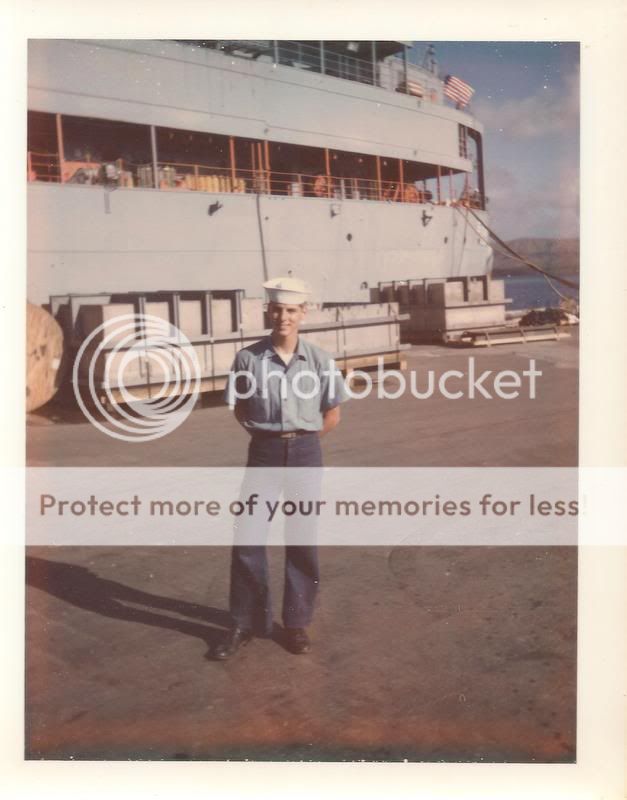
The battlefield in question is in the upper central highlands of Guam near Mt. Alutom. The following map shows the area. I was stationed on a submarine tender here in 1967 and decided to take some time to research the campaign to retake Guam from the Japanese which occurred in 1944. I had no idea what I'd find, but I looked at some maps from the ships library before I and some friends hiked miles into the mountains. I originally thought the unit involved in the action was the 77th infantry division, but after studying the map and the nature of what we found, I now believe that the unit involved was actually elements of the 3rd Marine division. The area where the photos were taken is East of Mt, Alutom and just Northeast of the Sigua river.
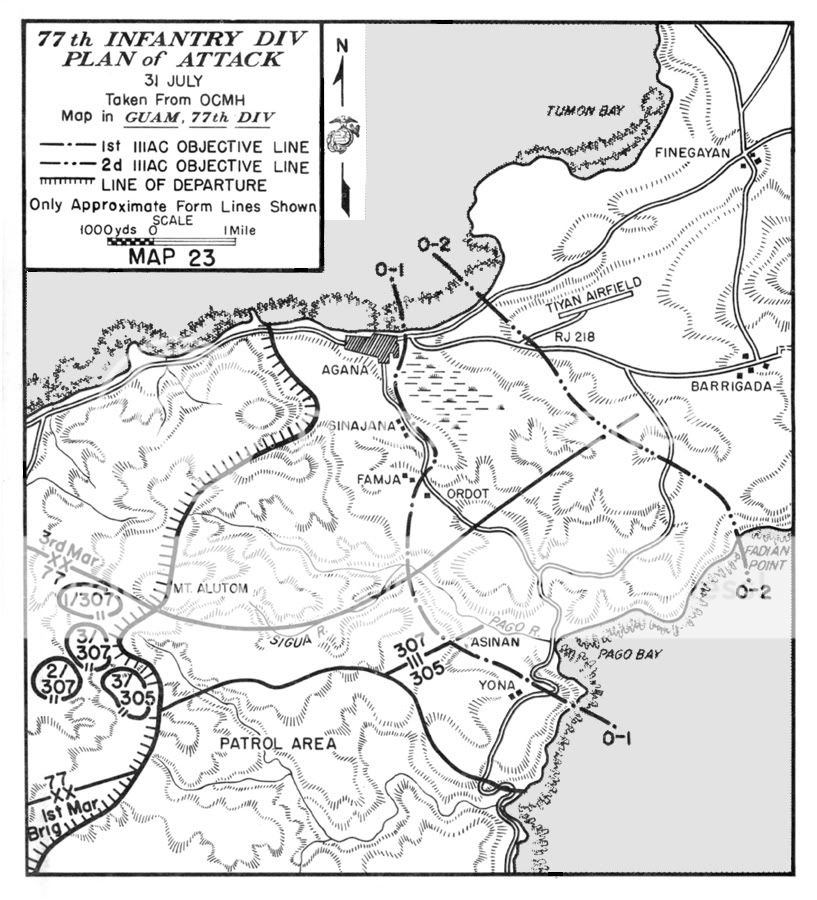
The first thing we ran across was some knocked out M4s. Judging by the design of the the transmission covers, I'd say these were a late-war production model about 1944. The one at the bottom may have hit a mine based on the the damage to tracks and wheels, but there was also something else evident.
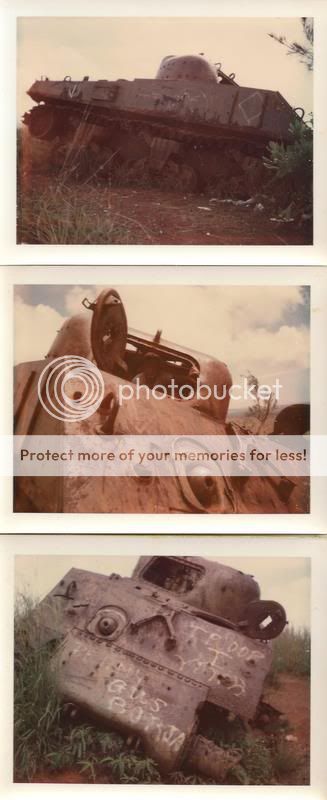
Look at the following photo of the same tank from a different angle. Notice the area in the shaded lower right hand corner. Judging by the finger-like scars on the 90 degree angle of the glacis plate weld, what I think was a 40mm (47mm?) HEAT round penetrated the driver compartment . You can see the hole just behind the front plate weld. I went inside and found that indeed, the round had gone all the way through. The driver would have been killed instantly if seated.
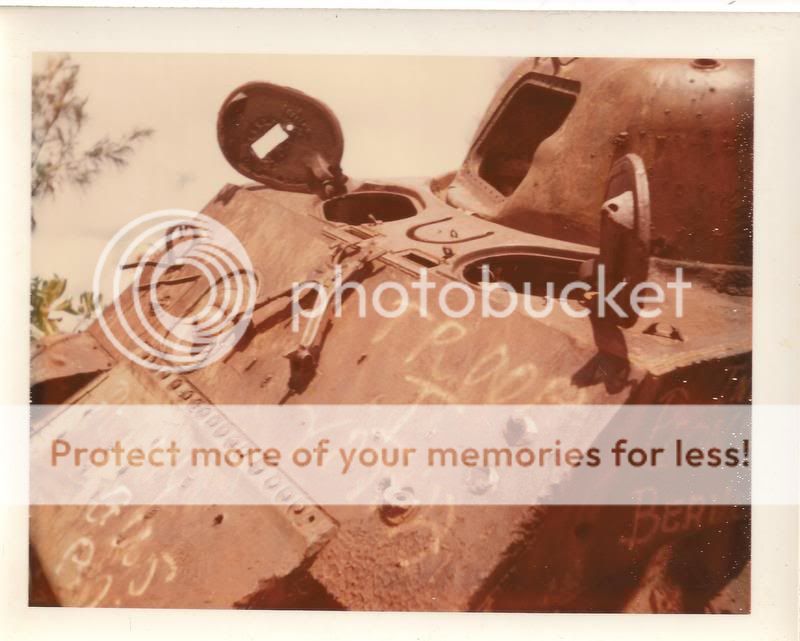
I took a couple of additional shots through the drivers hatch and the turret area looking forward. The one at the bottom
was a separate wreck which was largely intact. It appears that all weapons were removed from the vehicles shortly after the battle. No intact weapons were found on any US vehicles by us.
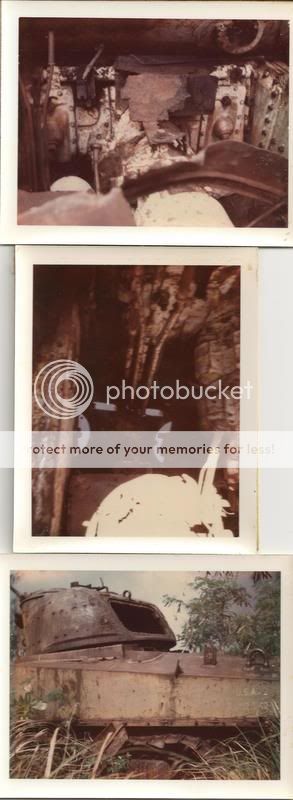
The next photos show an M4 largely intact. It appears it may have been mechanically disabled, but that's just a guess on my part. It also appears that a 37mm or 40mm AP round entered the vehicle through the coaxial machine gun ball mantlet.
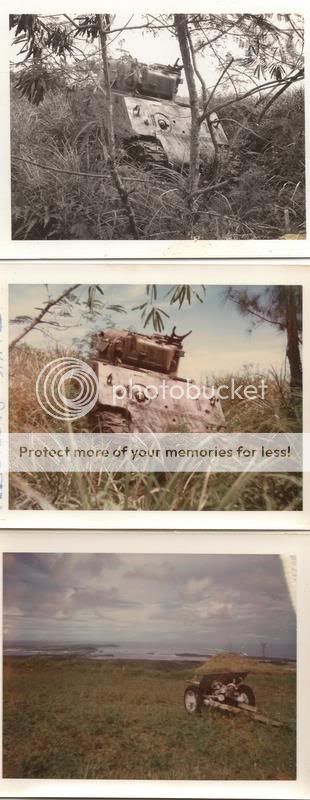
If you look at the center photo very carefully, you will see that 3 AP rounds struck the front of the tank more or less in a diagonal line. Two hit the glacis plate and did not penetrate. The third hit the transmission housing and may have gone through since the armor there is thinner. Look close --a fourth round went through the coaxial machine gun mantlet just to its left. This one did penetrate slightly based on my observation inside. Nasty. The bottom photograph shows a 40mm AT gun. We saw a fair number of these rusty things abandoned all over the island. They appeared intact, but the odd thing about them was that they all had been painted in standard Naval gray. Very strange.
[Postcript . What I thought were 40mm AT guns, may actually be the Japanese Type 1 47mm AT gun. Some recent photos I ran across seem to confirn this. It also explains why they were usually found facing the coast.
Why they were painted grey is still a mystery. This might have been done in the wake of the US advance to
quickly ID them as non-threatening, but thats just a wild guess on my part. US naval grey paint would have been the only thing available in quantity. ]
As we moved around the area in circles we encountered the first indication marine units were involved: Amtracks. It appears that they had been hit by medium field artillery, judging by the extent to which they were damaged. There were about four or five, and they were very badly damaged. In the bottom photo, you can't possibly see what I am holding, but it is a completely intact 30 cal Garand round. They were everywhere. All you had to do was dig into a sandy area a few inches and you would pull up 30 cal rounds in fireable condition with primers intact and very little deterioration. They were stamped 1943. Other things we found were hundreds of feet of buried communication wire.
In this area there were many small circular areas where vegetation did not grow. If you dug there, you found the metal and chemical fragments of heavy calibre naval artillery rounds which I know for a fact were used to bombard the Southern end of the island, and possibly called in later for support by forward observers. Many of the palm trees had been shredded at the Southern end of the island, but the North end escaped most such damage.
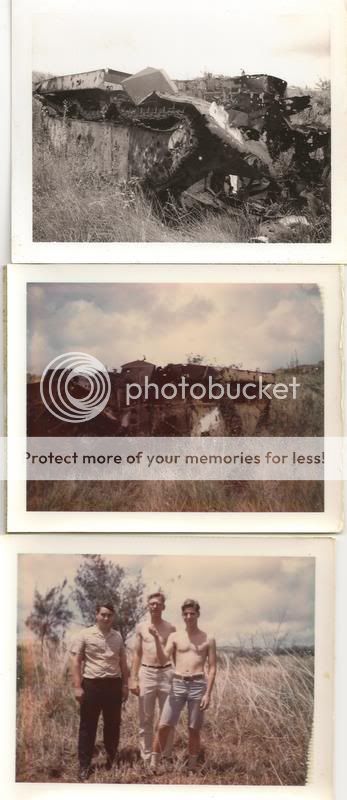
As we moved further East we encountered our first and only Japanese artifacts in the area: Light tanks. The first one had been deliberately dug in as an immobile pillbox.

The next vehicle we found was a surprise. A similar model Japanese tank with the main gun still intact. It appears to be a 37mm. We were surprised it wasn't removed.

This tank was essentially intact and appears to have been abandoned. Interestingly enough, the optics on the
gun were still intact, although the lenses were scuffed to uselessness by exposure to the weather.
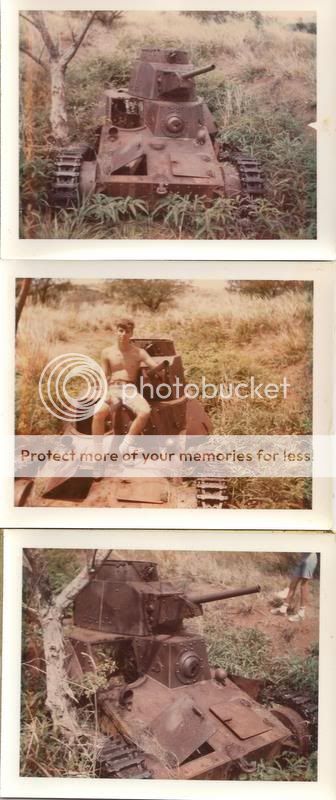
One last little interesting tidbit before we conclude our tour. Little did we know in 1967 that only a couple miles away from us that day was Shoichi Yokoi. This Japanese soldier was one of the last three such holdouts from WWII. He had been living in hiding near Talofofo falls for some twenty three years with one or two others. I did not read the story until 1972 when I was back home going to school. It floored me. Quite a number of times we had ridden on a motorcycle on the coast highway near Talofofo falls under the no doubt curious gaze of Sgt. Yokoi. Spooky. We had heard stories about Japanese stragglers firing random shots as late as 1946, and Guamanians complaining about lost laundry off clothes lines. But we hadn't a clue. The following link tells the story.
http://en.wikipedia.org/wiki/Shoichi_Yokoi
A brief tour through a real Pacific battlefield.
The following photographs were taken on Guam in 1967. Your tour guide will be G_Sajer (Clell Miller) as pictured below in the same year. Keep it in perspective, kids, these photos are 44 years old.

The battlefield in question is in the upper central highlands of Guam near Mt. Alutom. The following map shows the area. I was stationed on a submarine tender here in 1967 and decided to take some time to research the campaign to retake Guam from the Japanese which occurred in 1944. I had no idea what I'd find, but I looked at some maps from the ships library before I and some friends hiked miles into the mountains. I originally thought the unit involved in the action was the 77th infantry division, but after studying the map and the nature of what we found, I now believe that the unit involved was actually elements of the 3rd Marine division. The area where the photos were taken is East of Mt, Alutom and just Northeast of the Sigua river.

The first thing we ran across was some knocked out M4s. Judging by the design of the the transmission covers, I'd say these were a late-war production model about 1944. The one at the bottom may have hit a mine based on the the damage to tracks and wheels, but there was also something else evident.

Look at the following photo of the same tank from a different angle. Notice the area in the shaded lower right hand corner. Judging by the finger-like scars on the 90 degree angle of the glacis plate weld, what I think was a 40mm (47mm?) HEAT round penetrated the driver compartment . You can see the hole just behind the front plate weld. I went inside and found that indeed, the round had gone all the way through. The driver would have been killed instantly if seated.

I took a couple of additional shots through the drivers hatch and the turret area looking forward. The one at the bottom
was a separate wreck which was largely intact. It appears that all weapons were removed from the vehicles shortly after the battle. No intact weapons were found on any US vehicles by us.

The next photos show an M4 largely intact. It appears it may have been mechanically disabled, but that's just a guess on my part. It also appears that a 37mm or 40mm AP round entered the vehicle through the coaxial machine gun ball mantlet.

If you look at the center photo very carefully, you will see that 3 AP rounds struck the front of the tank more or less in a diagonal line. Two hit the glacis plate and did not penetrate. The third hit the transmission housing and may have gone through since the armor there is thinner. Look close --a fourth round went through the coaxial machine gun mantlet just to its left. This one did penetrate slightly based on my observation inside. Nasty. The bottom photograph shows a 40mm AT gun. We saw a fair number of these rusty things abandoned all over the island. They appeared intact, but the odd thing about them was that they all had been painted in standard Naval gray. Very strange.
[Postcript . What I thought were 40mm AT guns, may actually be the Japanese Type 1 47mm AT gun. Some recent photos I ran across seem to confirn this. It also explains why they were usually found facing the coast.
Why they were painted grey is still a mystery. This might have been done in the wake of the US advance to
quickly ID them as non-threatening, but thats just a wild guess on my part. US naval grey paint would have been the only thing available in quantity. ]
As we moved around the area in circles we encountered the first indication marine units were involved: Amtracks. It appears that they had been hit by medium field artillery, judging by the extent to which they were damaged. There were about four or five, and they were very badly damaged. In the bottom photo, you can't possibly see what I am holding, but it is a completely intact 30 cal Garand round. They were everywhere. All you had to do was dig into a sandy area a few inches and you would pull up 30 cal rounds in fireable condition with primers intact and very little deterioration. They were stamped 1943. Other things we found were hundreds of feet of buried communication wire.
In this area there were many small circular areas where vegetation did not grow. If you dug there, you found the metal and chemical fragments of heavy calibre naval artillery rounds which I know for a fact were used to bombard the Southern end of the island, and possibly called in later for support by forward observers. Many of the palm trees had been shredded at the Southern end of the island, but the North end escaped most such damage.

As we moved further East we encountered our first and only Japanese artifacts in the area: Light tanks. The first one had been deliberately dug in as an immobile pillbox.

The next vehicle we found was a surprise. A similar model Japanese tank with the main gun still intact. It appears to be a 37mm. We were surprised it wasn't removed.

This tank was essentially intact and appears to have been abandoned. Interestingly enough, the optics on the
gun were still intact, although the lenses were scuffed to uselessness by exposure to the weather.

One last little interesting tidbit before we conclude our tour. Little did we know in 1967 that only a couple miles away from us that day was Shoichi Yokoi. This Japanese soldier was one of the last three such holdouts from WWII. He had been living in hiding near Talofofo falls for some twenty three years with one or two others. I did not read the story until 1972 when I was back home going to school. It floored me. Quite a number of times we had ridden on a motorcycle on the coast highway near Talofofo falls under the no doubt curious gaze of Sgt. Yokoi. Spooky. We had heard stories about Japanese stragglers firing random shots as late as 1946, and Guamanians complaining about lost laundry off clothes lines. But we hadn't a clue. The following link tells the story.
http://en.wikipedia.org/wiki/Shoichi_Yokoi
Last edited:

